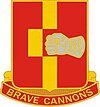92nd Field Artillery Regiment
This article includes a list of general references, but it lacks sufficient corresponding inline citations. (December 2012) |
| 92nd Field Artillery Regiment | |
|---|---|
 Coat of arms | |
| Country | |
| Branch | Army |
| Type | Field artillery |
| Motto(s) | BRAVE CANNONS |
| Insignia | |
| Distinctive unit insignia |  |
The 92nd Field Artillery Regiment is a field artillery regiment of the United States Army.
History
This section is empty. You can help by adding to it. (March 2011) |
Korean War
At the onset of the Korean War, the 92nd Field Artillery Battalion was detached from the 2nd Armored Division and deployed to Korea as an independent battalion under the command of Lt Col. Leon F. Lavoie. At the time, the unit was equipped with 155mm M41 Gorilla self-propelled howitzers. In a conflict in which enemy units frequently infiltrated or overran forward positions, the battlefield mobility and defensive firepower and armor of M-41 units was seen as being greatly preferable to that of towed artillery units, leading Lt Col. Lavoie to advocate for the conversion of all towed artillery to self-propelled chassis.[1] The 92nd is recorded as having fired the 150,000th and 300,000th artillery shells of the war.[2]
Lineage
This section is empty. You can help by adding to it. (June 2011) |
Distinctive unit insignia
- Description
A Gold color metal and enamel device 1 5/32 inches (2.94 cm) in height overall consisting of a shield blazoned: Gules, a pallet rompu Or, in sinister fess a dexter mailed clenched fist, couped at the wrist Proper. Attached below and to the sides of the shield a Red scroll inscribed “BRAVE CANNONS” in Gold letters.
- Symbolism
Scarlet and yellow are the colors used for Artillery. The mailed fist symbolizes the armored attack of the organization.
- Background
The distinctive unit insignia was originally approved for the 92nd Armored Field Artillery Battalion on 20 June 1942. It was redesignated for the 92d Artillery Regiment on 12 November 1958. The insignia was redesignated effective 1 September 1971, for the 92d Field Artillery Regiment.
Coat of arms
- Blazon
- Shield
Gules, a pallet rompu Or, in sinister fess a dexter mailed clenched fist, couped at the wrist Proper.
- Crest
On a wreath of the colors Argent and Gules a castle of the first with entrance arch Sanguine and two turrets inflamed Proper the battlements between the turrets supporting a Rose of Sharon also Proper and in base a bow fesswise Sable with drawstring Or armed with a fire arrow point up palewise inflamed all Proper. Motto BRAVE CANNONS.
- Symbolism
- Shield
Scarlet and yellow are the colors used for Artillery. The mailed fist symbolizes the armored attack of the organization.
- Crest
The fire arrow hurled from an arbalest, an early artillery weapon, symbolizes the mission of the battalion. The shape of the bow further alludes to the Battle of the Bulge in which the unit participated. The flames refer to the fire support provided in the Normandy invasion for which they were awarded the Presidential Unit Citation. The arrow further alludes to their assault landings and the medieval castle traditionally represents the areas in which the unit fought during World War II: Europe, France and Germany. The Rose of Sharon (the Korean national flower) symbolizes service in Korea for which they were awarded the Korean Presidential Unit Citation.
- Background
The coat of arms was originally approved for the 92nd Armored Field Artillery Battalion on 24 June 1942. It was redesignated for the 92d Artillery Regiment on 12 November 1958. It was amended to add a crest on 19 October 1965. The insignia was redesignated effective 1 September 1971, for the 92d Field Artillery Regiment.
Current configuration
- 1st Battalion 92nd Field Artillery Regiment (United States)
- 2nd Battalion 92nd Field Artillery Regiment (United States)
- 3rd Battalion 92nd Field Artillery Regiment (United States)
- 4th Battalion 92nd Field Artillery Regiment (United States)
- 5th Battalion 92nd Field Artillery Regiment (United States)
- 6th Battalion 92nd Field Artillery Regiment (United States)
See also
- 2nd Armored Division (United States)
- Field Artillery Branch (United States)
- Coats of arms of U.S. Artillery Regiments
References
![]() This article incorporates public domain material from 92nd Field Artillery Regiment. United States Army Institute of Heraldry.
This article incorporates public domain material from 92nd Field Artillery Regiment. United States Army Institute of Heraldry.
- ^ LaVoie, Leon F. (February 1952). "Make Mine SP: The mobility and devastating punch of the Self Propelled 155mm Howitzer, M41, paid off in Korea". United States Army Combat Forces Journal. Retrieved 30 March 2016.
- ^ "M41 Howitzer Motor Carriage". Military History Encyclopedia of the Web. Retrieved 29 March 2016.
